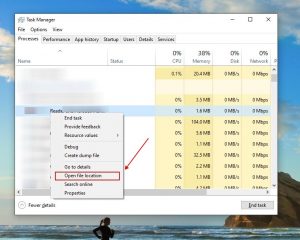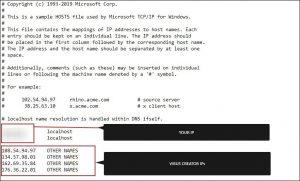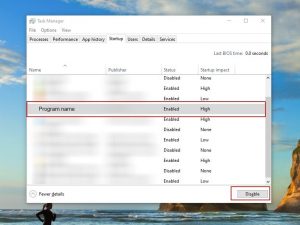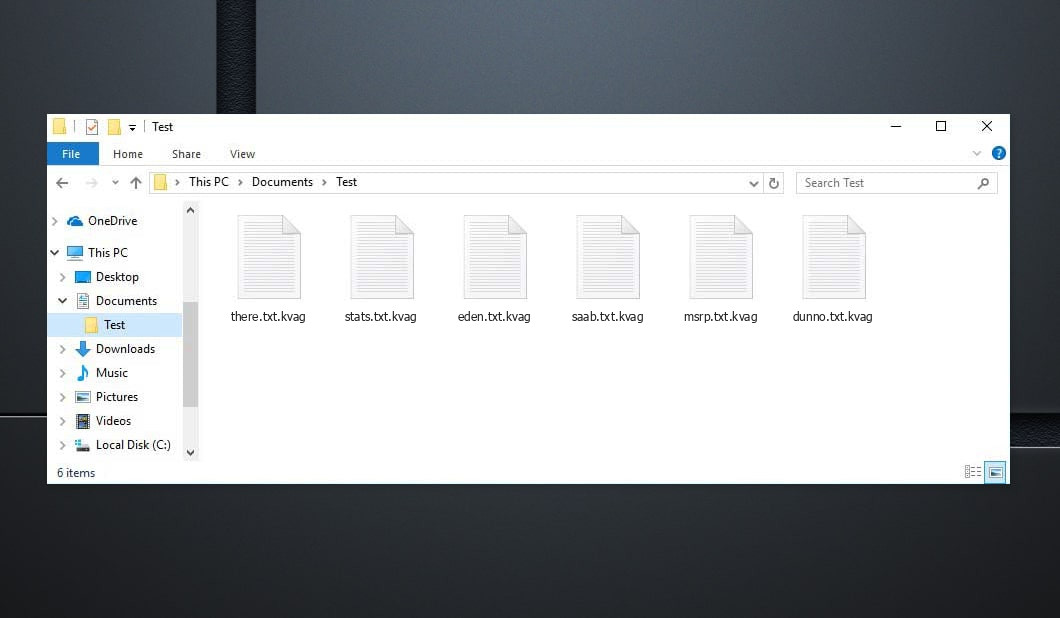This article intends to help you delete Kvag Ransomware at no cost. Our guidelines also explain how any Kvag ransomware file can be restored.
About Kvag
Kvag Ransomware stands for a cryptovirology PC threat used to blackmail its victims. Kvag Virus may not point to any evident symptoms, yet its presence is only discovered as soon as its job is performed.
The absence of symptoms is one of the main difficulties with this sort of PC viruses. They can penetrate into the attacked system unnoticed, and implement their work without showing their activity in the workstation. This is why most customers are not able to do anything to terminate the virus before it has completed its mission, and the mission of this one, in particular, is to make its victims’ files unusable by means of data ciphering and then indicating a ransom demand.
The user is reported via a message that this infection puts on their screen that their only solution of bringing their data back is via the payment of a certain amount of funds. This blackmailing component of this scam is very popular among the frauds, and there’s a whole group of PC malware that’s used in this manner. This malware category is named Ransomware, and the malware we are currently concentrating on definitely falls under it.
The Kvag malware is only disclosed once it has completed encrypting the documents. The .kvag Ransomware will then express its demands by means of an intimidating pop-up alert.It is via this alert that the users find out how they are expected to transfer their funds to the cyber frauds responsible for the Ransomware virus. In most instances, the ransom would be asked in a cryptocurrency – BitCoin. These cryptocurrencies are really hard to trace, and a typical user would have no chance of knowing who they are really transferring their funds to. This, in fact, makes it really unlikely that the hacker’s true identity would ever get disclosed. It is quite rare for a Ransomware hacker to stand before the court, and the application of cryptocurrency as the suggested payment solution is the main reason for that.
How to Kvag virus encrypt your files?
The .kvag Virus document encryption is not going to be eliminated after the ransomware is deleted. The .kvag Virus document encryption access key is promised to be given to you when you pay the ransom amount.
Nevertheless, it is not unusual for the hackers who stand behind such threats to promise their victims a decryption key for their encrypted documents only to refuse to provide that key as soon as the payment gets processed. Needless to mention, if you end up in a condition like this, you wouldn’t be capable of doing anything about it – your funds would be gone, and your data would still be inaccessible. This is why it isn’t really wise thought to transfer the payment, moreover, if you haven’t opted for any alternative options that may be effective.
Even though we mentioned that the encryption would remain on your documents even after the Ransomware is no longer in the system, deleting the virus is still extremely important. After you remove the Ransomware, you may also try the alternative file recovery solutions we have developed for you, and also your new files won’t be at risk of being encrypted. To delete this cryptoviral threat, you are recommended to complete the steps you will encounter below.
Kvag SUMMARY:
| Name | .kvag Virus |
| Type | Ransomware |
| Threat Level | High (Ransomware is so far the worst malware you can experience) |
| Symptoms | A Ransomware threat like this one would normally not reveal its presence until the documents get locked up. |
| Promotion Channel | Channels like spam e-mail promotion, and malvertising are normally the ones used to spread Ransomware. |
| Data Recovery Solution | Emsisoft Decrypter |
| Detection Utility |
.kvag may recover itself plenty of times if you don't get rid of its core files. We suggest downloading Loaris Trojan Remover to scan for malicious utilities. This may save you a lot of time and efforts to effectively get rid of all possible malware within your device.
Read more about Loaris Trojan Remover (License Agreement, Privacy Policy ).
If Loaris identifies a threat, you will need to buy a license to get rid of it. |
Delete Kvag Virus Ransomware
Some of the steps will likely demand you to exit the page. Bookmark it to easily get back to it later.
Reboot in Safe Mode (use this tutorial if you don’t know how to do it).
Click CTRL + SHIFT + ESC simultaneously and go to the Processes Tab. Try to identify which processes are malicious.

Right click on each of them and choose Open File Location. Then inspect the documents with online file checker:
Once you open their folder, end the processes that are contaminated, then get rid of their folders.
Note: If you are certain something is part of the threat – get rid of it, even if the scanner doesn’t mark it. No anti-virus application can identify all infections.
Keep holding the Win + R. And then copy & paste the following:
- notepad %windir%/system32/Drivers/etc/hosts
A new document will open. In case you are hacked, there will be a load of other IPs connected to your device at the bottom. Inspect the image below:

In case there are suspicious IPs below “localhost” – get in touch with us in the comments.
Use CTRL + SHIFT + ESC simultaneously and access the Startup Tab:

Proceed to Program Name and select “Disable”.
Keep in mind that ransomware may even include a fake developer name to its process. You must check out every process and be persuaded that it is legitimate.
To get rid of Kvag Virus, you may have to deal with system files and registries. Making a mistake and getting rid of the wrong thing may hurt your device.

You can prevent the system damage by selecting Loaris Trojan Remover - a high-quality Kvag removal software.
Read review about Loaris Trojan Remover (License Agreement, Privacy Policy ).
Look for the ransomware in your registries and get rid of the entries. Be very careful – you can destroy your system if you remove entries not associated with the ransomware.
Type each of the following in the Windows Search Field:
- %AppData%
- %LocalAppData%
- %ProgramData%
- %WinDir%
- %Temp%
Get rid of everything in Temp. Finally, simply check out for anything lately added. Don't forget to drop us a comment if you run into any issue!
How to Decrypt .kvag files?
Djvu Ransomware essentially has two versions.
- Old Version: Most older extensions (from “.djvu” up to “.carote (v154)”) decryption for most of these versions was previously supported by STOPDecrypter tool in case if infected files with an offline key. That same support has been incorporated into the new Emsisoft Decryptor for these old Djvu variants. The decrypter will only decode your files without submitting file pairs if you have an OFFLINE KEY.
- New Version: The newest extensions released around the end of August 2019 after the ransomware was changed. This includes .coharos, .shariz, .gero, .hese, .xoza, .seto, peta, .moka, .meds, .kvag, .domm, .karl, .nesa, .boot, etc….These new versions were supported only with Emsisoft Decryptor.
In case when the tutorial doesn’t help, download the anti-malware tool we suggest or try free online virus checker. Furthermore, you may always ask us in the comments for assistance!


kvag decryptor emisoft does not help me
why ?
KVAG
solution please my ID:
0163Asd483yiqgkhjdgxQlSxA4z91agmG8CudERLfLap12kD1CKRfbHgtde
Thank you.
To get this software you need write on our e-mail:
gorentos@bitmessage.ch
Reserve e-mail address to contact us:
gerentoshelp@firemail.cc
Your personal ID:
0163Asd483yiqgkhjdgDZtwvferAnN3SMhhwRBcuDUQ4mJlyNZyeQL6gxDf